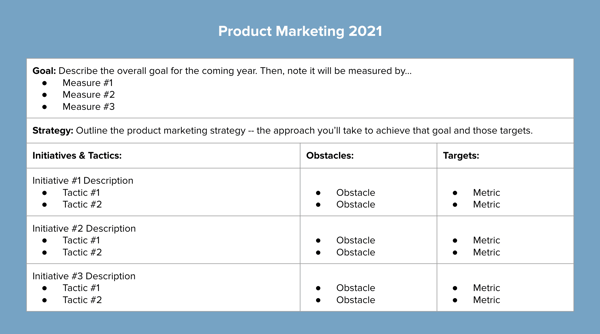The new year is here and it’s time to dive into the oh-so-beloved activity of building a marketing plan. OK, maybe it’s not so beloved - after all, it can be daunting and challenging to come up with “the perfect plan” to hit those great big goals this year. When you need to start somewhere, it can be helpful to think through the questions you want to answer around growth, strategies, and obstacles. When it comes to building a product marketing plan, in particular, these 16 questions will help you establish the foundations of a product marketing plan for a stellar year.
Part 1: Current State of the Market & Competitive Landscape
In order to establish a successful product marketing plan for the new year, it’s important to take a look at the current state of your market, how that has changed in the last year, and how you expect it to shift going forward. Then you can put your own company’s results in the context of the market and uncover opportunities for the coming year.
- What is the size of the market opportunity? Define your target market and put numbers to it. Note the parts of the market you currently serve and other potential expansion opportunities, such as new geographic markets or new verticals.
- How is the market growing or changing? No market sits still, so provide a review of how yours has changed in the last 1-3 years. This can inform where there is an opportunity for growth - is your market growing? What trends are apparent and how does that impact your business?
- Who are the key competitors and what makes them competitive? Now go deeper into understanding your market landscape by detailing the key players and what makes them competitive. What are their strengths and weaknesses, and what is leading to their success or failure?
- How has the competitive landscape changed? No competitor sits still, so recap their moves from the last year and pull out the trends - what new verticals, products, or messages are they focused on? What big milestones - or lack thereof - did they have and how did that change their trajectory? How did that impact the overall market dynamic as well as your own business more specifically?
- How has your company grown and changed? Looking back at the last 1-3 years, call out the biggest milestones, customer growth, competitive wins, etc. Benchmark your results in the context of the market - did your company double revenue, but your competitors tripled? Did you see flat growth despite the market size actually shrinking?
- What were the results and lessons from last year’s product marketing strategies? Recap the initiatives from the previous year and share the results. How did the team achieve its product launch goals, or competitive win/loss targets, and so on? What were the lessons learned that should be factored into the new plan?
- What are the risks and opportunities going into the new year? Putting together the answers from the above questions, you can now uncover the risks and opportunities going into the new year. What poses the biggest threats to the company’s success? New competitors, mergers of top rivals, market disruption? What are the greatest opportunities for growth? New verticals, new products, acquisitions?
- What are the other key assumptions of your product marketing analysis and plan? Share any other assumptions around overall initiatives, benchmarks, etc. that aren’t otherwise detailed in the above sections.
Elevate your product marketing strategy with this free kit >>
Part 2: Strategies & Tactics for the Coming Year
Now it’s time to paint a picture of your product marketing plan for the new year. Here’s where you define your strategies, key initiatives and tactics, as well as any obstacles and open questions.
- What are the key goals and metrics for the company this year? What does the company want to achieve, and what are they prioritizing? This sets the stage for product marketing priorities.
- What are the key goals and metrics for product marketing this year? With the context of the company’s goals, now translate that into how product marketing will support those targets. Highlight not only the goals but also the key performance indicators (KPIs), metrics to measure success.
- What is the overarching strategy in product marketing to achieve those goals? Now that you know what you want to achieve - how will you do it? What’s your approach and strategy to get to those targets?
- What are the top 3-5 product marketing initiatives that make up that strategy? It’s time to get specific, outlining the key initiatives for product marketing that make that strategy tangible. The initiatives can become key themes to be tackled by different members of the team - defining how each part of product marketing - such as product launches, competitive intelligence, or customer marketing - will support the strategy.
- What are the key tactics involved in those initiatives? Now you can break down the plan to be even more tangible, by listing the tactics involved in each of those initiatives. This exercise both helps other teams understand the nuts and bolts of your work, and helps you and your product marketing team think through the steps involved to achieve the outlined goals.
- What are the potential obstacles to achieving these initiatives? Obstacles are a natural piece of any strategy, and important to note upfront. By outlining the obstacles, you can adjust your tactics to work around or address these obstacles head-on. Either way, you go in with your eyes open - and can even ask for resources to help overcome those challenges.
The above can be covered in a single slide summary for clear and easy communication. Below is an example template.

Want to copy or download this slide? Here’s a Google Slides template you can copy and save for your own use.
Part 3: Asks & Open Questions
Finally, it’s time to pose any requests and open questions. For the audience of your plan, how can they help and what do you need from them to successfully achieve the plan you outlined?
- What open questions exist? As you put together this plan, there may be open questions for others - whether it be executive leadership or others in marketing or sales or product. Detail any questions that were not answerable prior to putting together your plan.
- What asks or requests do you have? Here’s where you outline your requests for budget or other resources such as new hires to achieve this plan. After building the case of the goals you want to hit, how that ties to the company’s targets and place in the market, opportunities that exist in the changing landscape, and how you will be able to do this, you can put forth those requests with a strong case. If needed, align each request to a particular initiative to show how and why this resource will be used.
Depending on the audience for this plan, you may need more or less detail for each of these questions. However, going through the exercise of answering each of these questions will help you, as the product marketing leader, think through each of the factors involved in a successful product marketing plan, and help you conquer your 2021 Product Marketing strategy.
Originally published December 4, 2018. Last updated on January 5, 2020

Seeing is believing! Check out Crayon for yourself.
Take a Product TourRelated Blog Posts
Popular Posts
-
 The 8 Free Market Research Tools and Resources You Need to Know
The 8 Free Market Research Tools and Resources You Need to Know
-
 6 Competitive Advantage Examples From the Real World
6 Competitive Advantage Examples From the Real World
-
 How to Create a Competitive Matrix (Step-by-Step Guide With Examples + Free Templates)
How to Create a Competitive Matrix (Step-by-Step Guide With Examples + Free Templates)
-
 24 Questions to Consider for Your Next SWOT Analysis
24 Questions to Consider for Your Next SWOT Analysis
-
 How to Measure Product Launch Success: 12 KPIs You Should Be Tracking
How to Measure Product Launch Success: 12 KPIs You Should Be Tracking



